✓ Accommodations✓ Flights✓ Rental Cars
You’re about to explore one of Japan’s most breathtaking natural treasures – a vast area that spans across four prefectures. Hakusan National Park is renowned for its sacred mountain and pristine nature, making it a must-visit destination for outdoor enthusiasts and nature lovers alike.
This comprehensive guide will walk you through the park’s untouched wilderness and cultural significance, highlighting the top experiences for visitors. Whether you’re an avid hiker or simply looking to immerse yourself in unspoiled nature, you’ll discover the essence of this remarkable national park.
Discovering Hakusan National Park: Japan’s Sacred Mountain Paradise
As you step into Hakusan National Park, you’re immediately enveloped in the serene beauty of Japan’s mountainous landscapes. This sacred site is not only a haven for nature enthusiasts but also a place of deep spiritual significance.
Geographic Overview and Park Significance
Hakusan National Park is located in central Japan, spanning across the Gifu, Ishikawa, and Fukui prefectures. The park is centered around Mount Hakusan, a mountain revered for its natural beauty and spiritual importance. The area is characterized by diverse ecosystems, ranging from temperate forests to alpine meadows.
The park’s significance extends beyond its natural beauty; it’s also a site of cultural and historical importance. The name “Hakusan” or “White Mountain” refers to the snow-capped peaks that remain white for much of the year. This mountain has been a sacred site for centuries, attracting pilgrims and nature lovers alike.
Best Seasons to Visit and What to Expect
The experience of visiting Hakusan National Park varies significantly with the season. When you visit in the summer months of July and August, you’re treated to a spectacular display of alpine flowers in bloom. The park’s trails are particularly vibrant during this time, with the rare Hakusan kozakura adding to the colorful tapestry.
Here’s what you can expect during different times of the year:
- Summer (July-August) is ideal for hiking and witnessing the alpine flower blooms.
- Autumn brings a kaleidoscope of colors as the foliage changes, particularly along the Chiburi Ridge.
- Winter transforms the park into a snow-covered landscape, making it a challenge for all but experienced mountaineers.
- Spring is a time of renewal, with flora blooming at various elevations as the snow melts.
Each season offers a unique charm, making Hakusan National Park a year-round destination. Whether you’re interested in hiking, nature photography, or simply experiencing the tranquility of the natural world, there’s a visit time that’s right for you.
Hiking the Iconic Trails of Hakusan National Park
As you step into Hakusan National Park, the allure of its iconic trails beckons you to explore the natural beauty that lies within. The park is renowned for its diverse hiking trails, each offering a unique experience that caters to different levels of adventure and exploration.
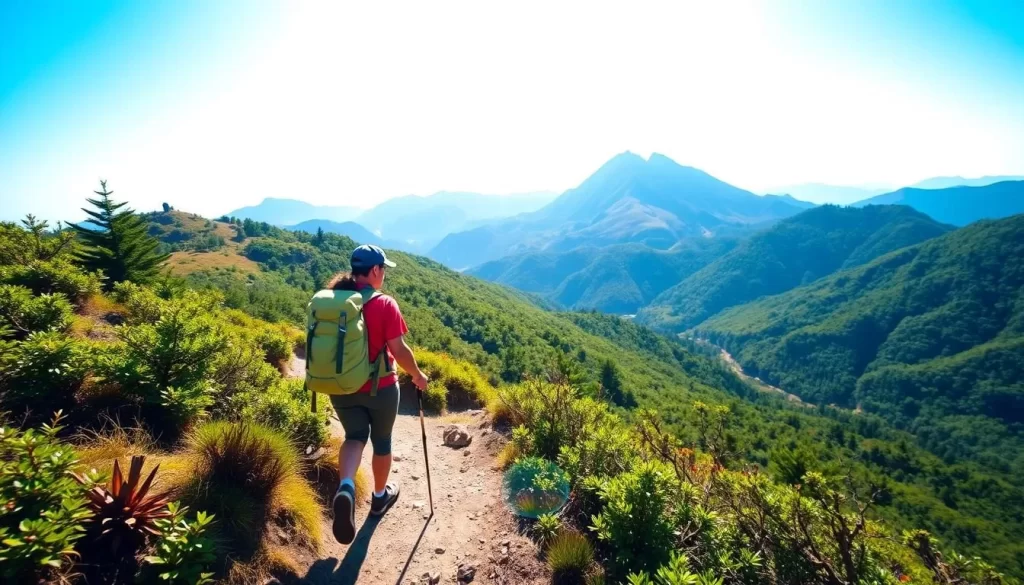
Bessan-Ichinosedo Trail: The Most Popular Route
The Bessan-Ichinosedo Trail is the most frequented route in Hakusan National Park, attracting a significant number of visitors each year. This trail is favored for its relatively accessible terrain and the spectacular views it offers of the surrounding landscape.
As you hike along this trail, you’ll be treated to vistas of the mountain peaks and the serene water bodies that dot the landscape. The trail is well-marked and maintained, making it an ideal choice for both novice and experienced hikers.
Trail Highlights
The Bessan-Ichinosedo Trail is notable for its diverse flora and fauna, as well as its historical significance. Along the way, you’ll encounter ancient shrines and other cultural landmarks that add a layer of depth to your hiking experience.
Hirasedo and Chugudo Routes: Alternative Paths to the Summit
For those seeking a more challenging adventure, the Hirasedo and Chugudo routes offer alternative paths to the summit of Mount Hakusan. These trails are less crowded than the Bessan-Ichinosedo Trail, providing a more secluded and intimate experience with nature.
The Hirasedo trail winds down the mountain’s eastern slope from Murodo, eventually leading to the stunning Lake Hakusui. This artificial lake is known for its turquoise water, which is a result of its high sulfur content. The primeval beech forest of Oshirakawa is reflected beautifully in its waters, creating a breathtaking spectacle.
As you hike the Chugudo route, you’ll traverse through diverse vegetation zones, witnessing the transition from dense beech forests to alpine meadows as you gain elevation. Both trails connect to the main summit area, allowing visitors flexibility in planning either loop hikes or point-to-point journeys across different sections of the park.
Exploring the Sacred Peaks of Mount Hakusan
Embark on a pilgrimage to the revered peaks of Mount Hakusan, where nature’s splendor and spiritual significance converge. The mountain range is home to three majestic peaks: Gozengamine, Kengamine, and Onanjimine. These peaks are not just geographical landmarks but are deeply intertwined with the spiritual and cultural heritage of the region.

Gozengamine: The Highest Peak and Its Spiritual Significance
Gozengamine stands as the highest peak in the Hakusan range, reaching an elevation of 2,702 meters. This peak is not only a marvel of natural beauty but also holds significant spiritual importance. Hikers and pilgrims alike are drawn to its grandeur, seeking a connection with the divine amidst the breathtaking landscapes.
As you ascend to Gozengamine, you’ll be rewarded with panoramic views that stretch across the surrounding landscape. The trail to the summit is well-marked and offers a challenging yet rewarding hike. The spiritual significance of Gozengamine is deeply rooted in the local culture, with the peak being a focal point for mountain worship and pilgrimage.
Kengamine and Onanjimine: Completing the Three Peaks
The journey to fully experience Mount Hakusan involves visiting all three of its main peaks. After reaching Gozengamine, hikers often proceed to Kengamine and Onanjimine, completing a circuit that offers diverse perspectives on the mountain’s beauty. Kengamine, standing at 2,677 meters, provides unique views of the surrounding area, while Onanjimine, at 2,648 meters, rewards hikers with dramatic vistas of the volcanic landscapes.
- You’ll discover that conquering Mount Hakusan fully means visiting all three of its main peaks, which together form the sacred trinity of this mountain range.
- When approaching from the northern routes, you’ll typically encounter Onanjimine first, then proceed to Kengamine, before finally reaching the highest point at Gozengamine, creating a natural progression of increasing elevation and expanding views.
- Kengamine offers you unique perspectives of the surrounding landscape that complement rather than duplicate the vistas from Gozengamine, making it worth the additional effort to visit.
- Onanjimine rewards you with excellent views of the other summits and the dramatic volcanic landscapes that characterize this area of the park.
- Hiking between all three peaks typically takes a full day, requiring good physical conditioning and proper preparation, but the sense of accomplishment and the comprehensive mountain experience make it one of the most rewarding adventures in the park.
By exploring these three peaks, you’ll gain a deeper appreciation for the natural and spiritual significance of Mount Hakusan. The experience is not just about the hike; it’s about connecting with a place that has been revered for centuries.
Witnessing Hakusan’s Breathtaking Alpine Flora
As you explore Hakusan National Park, you’ll be treated to a breathtaking display of alpine flowers that thrive in the mountain’s unique environment. The park’s diverse elevations and geological history have created a haven for a wide variety of flora, making it a paradise for botanists and nature enthusiasts alike.
Summer Wildflower Spectacle: July and August Blooms
During the summer months, particularly July and August, Hakusan National Park comes alive with a vibrant display of wildflowers. The trails, such as the one from Murodo to Itoshiro, are lined with a variety of colorful blooms that add to the park’s natural beauty. As you walk through the flower-dotted plains, you’ll have the opportunity to see these flowers up close.
The Minamiryuugabanba plain is a highlight, with its wooden walkways that guide you through a sea of delicate Hakusan kozakura (Primula cuneifolia var. hakusanensis Makino) flowers. This rare pink primrose is found nowhere else in the world except on Mount Hakusan, making it a true botanical treasure.
| Flower Name | Blooming Period | Location |
|---|---|---|
| Hakusan Kozakura | July-August | Minamiryuugabanba Plain |
| Alpine Gentian | August-September | Murodo to Itoshiro Trail |
| Lily of the Valley | June-July | Various Trails |
Rare Plant Species: Hakusan Kozakura and Other Endemic Flora
Hakusan National Park is home to a number of rare and endemic plant species that have evolved in isolation on the mountain. The Hakusan kozakura, with its delicate pink petals, is one such example. As you explore the park’s trails, you’ll come across other unique species that have adapted to the harsh mountain conditions.
The park’s conservation efforts, including designated boardwalks and educational programs, help protect these fragile habitats. By learning about and appreciating these botanical wonders, you can play a part in their preservation.
As you walk through the plains and trails, you’ll notice the unique adaptations of these plants, such as compact growth forms and vibrant colors that attract pollinators during the short growing season. The park’s unique geological history and varied elevations have resulted in an unusually high number of endemic flora, making it a fascinating destination for botanists and nature lovers.
Wildlife Encounters in Hakusan’s Pristine Wilderness

As you venture into Hakusan National Park, you’ll discover a rich tapestry of wildlife, from majestic golden eagles to elusive Japanese serows. The park’s pristine wilderness offers a unique opportunity for visitors to observe native animals in their natural habitat.
Spotting Japanese Serows, Golden Eagles, and Asiatic Black Bears
The diverse landscapes of Hakusan National Park are home to a wide range of wildlife. Among the notable species are the Japanese serow, known for its distinctive horns and agile movements, and the golden eagle, a symbol of power and freedom. Asiatic black bears also inhabit the park, often seen in areas with abundant food sources.
To maximize your chances of spotting these incredible creatures, it’s essential to understand their habitats and behaviors. The park’s varied terrain, from dense forests to alpine meadows, supports a rich ecosystem that sustains a variety of animals.
Mt. Bunao Observation House: The Premier Wildlife Viewing Spot
For an unparalleled wildlife viewing experience, visit the Mt. Bunao Observation House, strategically located to offer insights into the natural behaviors of Hakusan’s native animals. Open from November 20 to May 5, this facility is particularly popular during winter when the snowy landscape makes wildlife more visible.
- The observation house is equipped with professional-grade spotting scopes, allowing visitors to get a closer look at the wildlife without disturbing them.
- Knowledgeable staff are on hand to provide guidance, helping you identify species such as Japanese serows, golden eagles, and Japanese macaques.
- The facility’s design ensures minimal human disturbance, with one-way glass windows and a quiet environment that allows for the observation of natural behaviors.
- Plan your visit for early morning or late afternoon when wildlife activity peaks, and be prepared to spend a couple of hours for the best experience.
Located near the mountain trails, the Mt. Bunao Observation House is an ideal stop for those exploring Hakusan National Park. It serves as a valuable resource and center for learning about the park’s wildlife and conservation efforts.
Exploring Hakusan’s Volcanic Landscapes
As you explore Hakusan National Park, you’ll discover the captivating beauty of its volcanic landscapes. The park’s unique geology has created a fascinating environment that is both beautiful and scientifically interesting.
Minamiryuugabanba and Murodo Plains: Volcanic Wonders
The Minamiryuugabanba and Murodo Plains are notable volcanic features within Hakusan National Park. These areas showcase the park’s volcanic history through their unique landforms and geological processes. The volcanic plains offer a glimpse into the forces that have shaped the mountain over time.
As you hike through these areas, you’ll notice the distinctive rock formations and the impact of volcanic activity on the local ecosystem. The terrain is dotted with features that highlight the dynamic geological processes at work in the park.
- The volcanic plains provide a unique habitat for various plant and animal species.
- The geological formations are a testament to the region’s volcanic past.
- Hiking trails in these areas offer breathtaking views of the surrounding landscape.
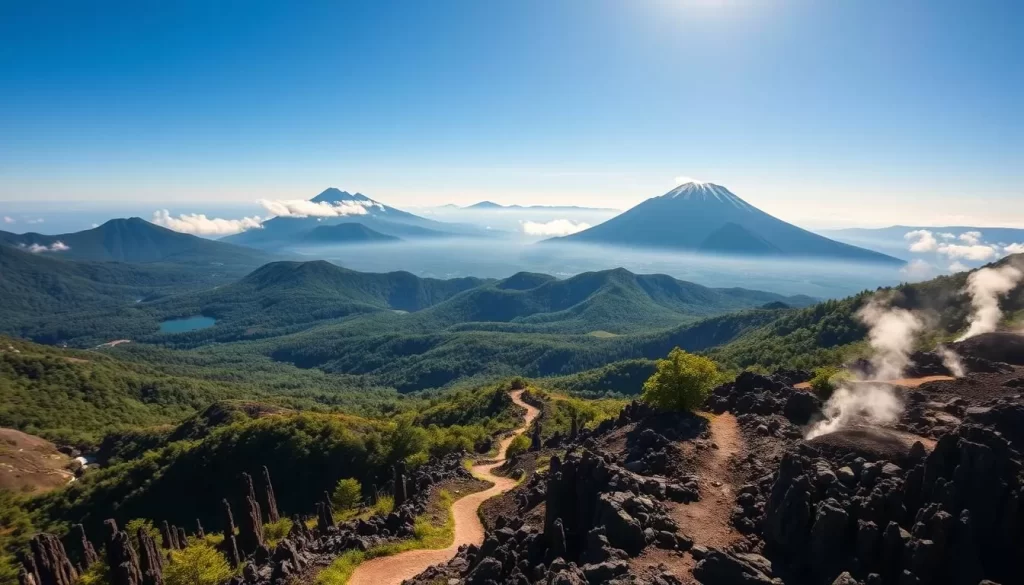
Crater Lakes and Geological Formations
The Oike-Meguri Hiking Trail is a two-hour loop that takes you around seven crater lakes and ponds, offering a unique perspective on the park’s volcanic features. Each body of water has different mineral compositions and colors, creating a visually striking experience.
As you walk along the trail, you’ll observe how the lakes change with the seasons, from clear summer waters to partially frozen surfaces in spring and fall. This variation offers numerous natural beauty opportunities for photography and appreciation of the park’s diverse landscapes.
The mountain‘s geological formations tell the story of Hakusan’s volcanic history, with steam vents, mineral deposits, and colorful patterns along the shorelines. The trail provides access to Gozengamine, the highest peak, while circling around these crater lakes, giving hikers a comprehensive experience of the park’s volcanic landscapes.
Hakusan National Park, Japan: Best Things to Do – Top Picks for Nature Lovers
With its rich biodiversity and stunning landscapes, Hakusan National Park is a paradise for nature lovers. The park offers a diverse range of natural wonders, from majestic waterfalls to serene lakes, and from lush forests to rugged mountain peaks.
Hyakuyojo Falls: The Park’s Most Spectacular Waterfall
One of the top attractions in Hakusan National Park is the breathtaking Hyakuyojo Falls, a must-see waterfall that showcases the park’s natural beauty. As you approach the falls, you’ll be struck by the roar of cascading water and the mist that creates a refreshing atmosphere.
Hyakuyojo Falls is not just a visual spectacle; it’s also an experience that rejuvenates the spirit. The falls are surrounded by lush vegetation, creating a serene environment that’s perfect for nature walks and photography.
Lake Hakusui: Turquoise Waters and Reflective Beauty
At the end of the Hirasedo trail lies the stunning Lake Hakusui, a vast artificial lake known for its striking turquoise colors. The lake’s unique color is due to its high sulfur content, a reminder of the volcanic nature of the Hakusan area. As you stand by the lake, you’ll witness the perfect reflection of the surrounding mountain peaks and the primeval beech forest of Oshirakawa, creating a mirror-like effect that is both breathtaking and serene.
- The lake’s turquoise waters are mesmerizing, with colors that change subtly with the weather and seasons.
- You can enjoy the lake from multiple vantage points, including lakeside paths that offer different perspectives.
- The tranquil atmosphere at Lake Hakusui is perfect for resting and observing the local wildlife.
As you explore Lake Hakusui, take a moment to appreciate the water‘s edge, where you can observe the play of light on the surface and perhaps spot waterfowl that frequent this peaceful habitat.
Immersing in Hakusan’s Ancient Mountain Worship Culture
As you explore Hakusan National Park, you’ll discover a rich history of spiritual practices that date back centuries. The park is home to numerous cultural and historical sites that reflect the deep-rooted mountain worship culture of the region.
Shirayamahime-jinja: The Head Shrine of Hakusan
At the heart of Hakusan’s spiritual heritage is Shirayamahime-jinja, the head shrine dedicated to the deity of Mount Hakusan. This shrine has been a central figure in the mountain worship practices of the region for centuries, attracting pilgrims from across Japan.
Historical Significance: Shirayamahime-jinja is not only a religious site but also a repository of historical artifacts and knowledge. The shrine complex includes various structures, each with its own unique history and significance.
| Structure | Description | Historical Significance |
|---|---|---|
| Honden | The main hall where the deity is enshrined | Represents the spiritual heart of the shrine |
| Haiden | The oratory hall where prayers are offered | Serves as a place for devotees to connect with the divine |
| Torii Gate | The entrance gate marking the transition to sacred space | Symbolizes the boundary between the secular and sacred worlds |
Following Ancient Pilgrimage Routes: The Zenjodo Trails
The Zenjodo trails are a network of ancient pilgrimage routes that crisscross Hakusan National Park. These trails were used by practitioners of mountain worship as a form of spiritual training, known as “zenjo.”
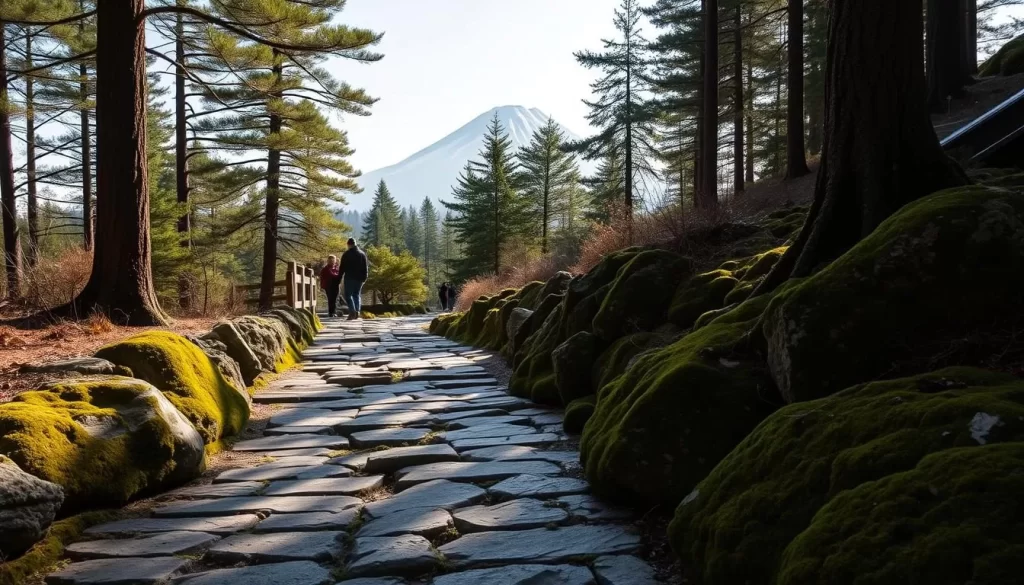
As you hike these historic trails, you’ll follow in the footsteps of countless pilgrims who have traversed these paths for centuries. The trails include three main routes: Echizen-zenjodo, Kaga-zenjodo, and Mino-zenjodo, each representing different regional traditions of mountain worship.
- The Echizen-zenjodo route passes through scenic landscapes and historic sites, offering a glimpse into the spiritual practices of the past.
- The Kaga-zenjodo route is known for its challenging terrain, reflecting the ascetic nature of the pilgrimage.
- The Mino-zenjodo route features unique geological formations and offers breathtaking views of the surrounding mountains.
By exploring these ancient pilgrimage routes, you’ll gain a deeper understanding of the history and culture of mountain worship in the region, as well as a profound appreciation for the natural beauty of Hakusan National Park.
Relaxing in Hakusan’s Rejuvenating Hot Springs
Hakusan National Park offers more than just hiking trails; it’s also home to rejuvenating hot springs perfect for relaxation. After a day of exploring the park’s rugged landscapes, you can unwind in the serene hot springs that dot the surrounding area.
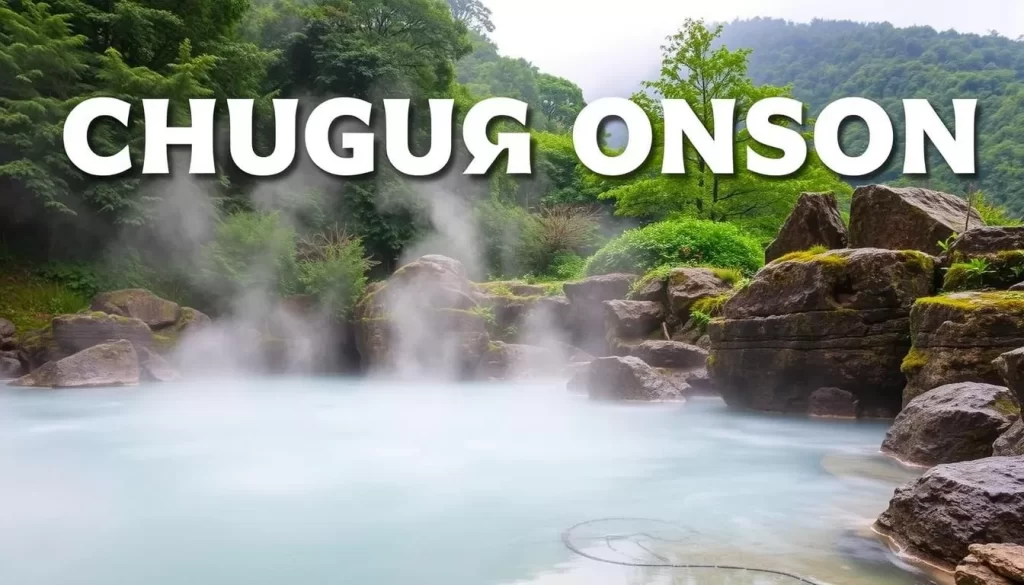
Chugu Onsen: The Park’s Premier Hot Spring Experience
Chugu Onsen is a standout hot spring within Hakusan National Park, offering a premier hot spring experience. This onsen (hot spring) is known for its high-quality waters and serene atmosphere, making it an ideal spot to relax and rejuvenate.
The alkaline waters of Chugu Onsen are particularly noted for their silky texture, leaving your skin feeling smooth and rejuvenated. It’s the perfect place to soothe your muscles after a long hike on the park’s trails.
Other Notable Hot Springs Around the Park
Beyond Chugu Onsen, there are several other noteworthy hot springs scattered around the perimeter of Hakusan National Park. Each of these hot springs offers unique mineral compositions and bathing experiences that reflect the local geology.
For instance, Shiramine Onsen in the historic village of Shiramine provides a cultural hot spring experience. Here, you can soak in healing waters surrounded by traditional Japanese architecture, enhancing the relaxing ambiance.
At Ichirino Onsen near the western entrance to the park, you’ll find multiple bathing facilities ranging from public baths to ryokan (traditional inns) with private hot spring baths. This makes it a popular destination for overnight stays, allowing you to fully immerse in the therapeutic waters.
Visiting these peripheral hot springs during the shoulder seasons (late spring or early fall) can be particularly rewarding. You can enjoy comfortable hiking conditions in the park and less crowded bathing experiences in these therapeutic waters.
Exploring the Historic Villages Near Hakusan
As you venture beyond the natural wonders of Hakusan National Park, you’ll discover historic villages that offer a glimpse into Japan’s rich cultural heritage. The area surrounding the park is home to several villages, each with its unique history, architecture, and cultural significance.
Shiramine: An Important Traditional Buildings Preservation District
Shiramine is a historic village located near Hakusan National Park, known for its well-preserved traditional architecture. This village has been designated as an Important Traditional Buildings Preservation District, recognizing its cultural and historical value. As you explore Shiramine, you’ll notice the traditional buildings, some of which date back centuries, showcasing the region’s architectural heritage.
The village is not just a collection of old buildings; it’s a living, breathing community where traditional ways of life continue. You can experience the local culture firsthand by visiting the village’s historic homes, some of which have been converted into museums or are still inhabited by local families.
| Feature | Description |
|---|---|
| Traditional Architecture | Historic buildings showcasing the region’s architectural style |
| Cultural Significance | Designated as an Important Traditional Buildings Preservation District |
| Community | A living village with ongoing traditional practices |
Shirakawa-go: UNESCO World Heritage Gassho-Zukuri Houses
Shirakawa-go is another historic village near Hakusan National Park, renowned for its gassho-zukuri houses. These traditional farmhouses are characterized by their steep thatched roofs, which resemble hands clasped together in prayer. This unique architectural style was developed to withstand the heavy snowfall in the region and to provide space for sericulture in the attics.
As a UNESCO World Heritage Site, Shirakawa-go attracts visitors from around the world. The village is particularly enchanting during winter evenings when the houses are illuminated, or during spring when the cherry blossoms bloom, and in autumn when the foliage changes.
The village maintains its traditional way of life while accommodating visitors. Some of the gassho-zukuri houses serve as museums, offering insights into the traditional lifestyle and practices of the local community, while others remain family homes.
| Season | Experience |
|---|---|
| Winter | Illuminated houses and snow-covered landscapes |
| Spring | Cherry blossoms surrounding the village |
| Autumn | Vibrant autumn foliage |
Visiting these historic villages near Hakusan National Park provides a well-rounded experience, combining the natural beauty of the park with the cultural richness of its surroundings. Whether you’re interested in history, architecture, or simply experiencing traditional Japanese culture, these villages are a must-visit destination.
Seasonal Highlights: When to Visit Hakusan National Park
From the blooming wildflowers of summer to the serene snow-covered landscapes of winter, Hakusan National Park is a destination for every season. The park’s diverse geography and climate mean that each time of year offers a unique set of experiences and attractions.
Summer Adventures: Alpine Flowers and Ideal Hiking Conditions
Summer is a peak season for visiting Hakusan National Park, with warm weather and long days making it ideal for hiking and exploring the park’s many trails. The alpine meadows are in full bloom, with a vibrant display of wildflowers including the rare Hakusan Kozakura.
You can enjoy the park’s many hiking trails, ranging from easy day hikes to more challenging multi-day treks. The Bessan-Ichinosedo Trail is a popular choice, offering breathtaking views of the surrounding mountains and valleys.

Autumn Splendor: Experiencing the Fall Foliage
Autumn brings a kaleidoscope of color to Hakusan National Park, as the leaves of the deciduous trees turn brilliant shades of orange, red, and yellow. The contrast between the vibrant foliage and the rugged mountain landscape is truly spectacular.
You can enjoy the fall colors along the park’s many hiking trails, or take a leisurely drive along the Hakusan Shirakawa-go White Road, which offers stunning views of the surrounding mountains.
| Season | Main Attractions | Activities |
|---|---|---|
| Summer | Alpine flowers, green landscapes | Hiking, wildlife viewing |
| Autumn | Fall foliage, harvest scenery | Hiking, photography, driving scenic routes |
| Winter | Snow-covered landscapes, frozen waterfalls | Snowshoeing, skiing, wildlife viewing |
Winter Wonders: Snow-Covered Landscapes and Nearby Ski Resorts
Winter transforms Hakusan National Park into a serene and peaceful landscape, with deep snow covering the mountains and valleys. While some areas of the park may be inaccessible due to heavy snowfall, there are still plenty of opportunities to enjoy the winter scenery.
You can explore the park’s lower elevations on snowshoes, or visit the Mt. Bunao Observation House to spot wildlife such as Japanese serows and Asiatic black bears. The nearby Ichirino Onsen Ski Resort offers excellent skiing and snowboarding opportunities.
- Experience the unique “snow volcano” formation at Hyakuyojo Falls.
- Enjoy snowshoeing and wildlife viewing in the park’s lower elevations.
- Take advantage of skiing and snowboarding at Ichirino Onsen Ski Resort.
Visitor Centers and Educational Experiences
To deepen your understanding of Hakusan’s natural wonders, visit the park’s informative visitor centers. These facilities are designed to enhance your experience by providing insights into the park’s unique geological features, biodiversity, and cultural significance.

Ichinose Visitor Center: Your Gateway to Hakusan
The Ichinose Visitor Center serves as an excellent starting point for your journey into Hakusan National Park. Here, you can gain a comprehensive understanding of the park’s ecosystems and the importance of conservation efforts. The center offers detailed information about the trails, including maps and safety guidelines, ensuring that you’re well-prepared for your adventure.
Key Features of Ichinose Visitor Center:
- Informative exhibits on the park’s flora and fauna
- Detailed trail maps and safety information
- Knowledgeable staff available to answer questions
Chugu Exhibition Hall and Hakusan National Park Center
Beyond the Ichinose Visitor Center, the Chugu Exhibition Hall and Hakusan National Park Center offer further educational experiences. The Chugu Exhibition Hall, located near Chugu Onsen, provides specialized information about the volcanic formation of Mount Hakusan and its impact on the surrounding landscapes. Meanwhile, the Hakusan National Park Center focuses on the park’s diverse flora and fauna, with a particular emphasis on endemic species.
The Chugu Exhibition Hall offers insights into the geological history of the area, while the Hakusan National Park Center provides a deeper understanding of the park’s biodiversity. Both facilities enhance your appreciation of Hakusan National Park’s natural treasures through interactive displays, educational films, and multimedia presentations.
Highlights of Chugu Exhibition Hall and Hakusan National Park Center:
- Interactive displays on geological and biological aspects
- Educational films and multimedia presentations
- Exhibits on endemic species and conservation efforts
Practical Tips for Visiting Hakusan National Park
Before you embark on your journey to Hakusan National Park, here are some practical tips to keep in mind. Planning ahead will ensure that your trip is both safe and enjoyable.
Transportation Options and Access Points
Getting to Hakusan National Park involves choosing the right transportation options. The nearest major city is Kanazawa, which has a well-connected train station. From Kanazawa, you can take a bus or train towards the park. The most common access points include the Shiramine and Bessan areas, which serve as gateways to various trails within the park.
It’s advisable to check the latest transportation schedules and plan your route in advance, as services can be limited, especially during off-peak seasons. Mountain weather can be unpredictable, and being prepared for changing conditions is crucial.
Accommodation Choices: Mountain Huts, Campsites, and Nearby Hotels
Hakusan National Park offers a range of accommodation options to suit different preferences and budgets. For those who enjoy camping, there are designated campsites within the park. Alternatively, mountain huts provide basic lodging for hikers and trekkers. For a more comfortable stay, hotels in nearby towns like Shiramine and Kanazawa offer a relaxing retreat after a day’s exploration.
When choosing your accommodation, consider the weather and your planned activities. Ensure that your chosen accommodation provides the necessary amenities and is conveniently located for your itinerary.
Essential Gear and Safety Considerations
Proper preparation is key to a safe and enjoyable visit to Hakusan National Park. You’ll need gear such as sturdy, waterproof boots, layered clothing for changing weather conditions, and rain protection. It’s also essential to carry safety items like a detailed topographic map, compass or GPS device, first aid kit, headlamp with extra batteries, emergency shelter, and sufficient water and high-energy food.
- Always carry bear bells and know proper bear safety protocols, as Asiatic black bears inhabit the park.
- Check the latest weather forecasts before setting out and be prepared to turn back if conditions deteriorate.
- Inform someone of your planned route and expected return time, as cell phone coverage is limited.
By being well-prepared and aware of the potential hazards, you can have a safe and enjoyable experience in Hakusan National Park.
Day Trip Itineraries for Different Interests
Whether you’re a casual visitor or a dedicated hiker, Hakusan National Park has day trip itineraries tailored to your needs. The park offers a variety of trails and routes that cater to different interests and fitness levels, ensuring that everyone can experience the beauty of Hakusan.
For Casual Visitors: Easy Access Points and Short Trails
Casual visitors can enjoy the park’s scenic beauty without embarking on a challenging hike. The Bessan-Ichinosedo Trail is a popular choice, offering stunning views of the surrounding mountains and valleys. Although it’s considered a moderate trail, it’s accessible for those who want to experience the park’s highlights without excessive strain.
For an even easier experience, the Hyakuyojo Falls is a great destination. This scenic waterfall is accessible via a short, paved path, making it suitable for families or those with mobility issues. The falls are particularly beautiful during the spring and early summer when the surrounding flora is in bloom.
| Trail Name | Difficulty Level | Approximate Time |
|---|---|---|
| Bessan-Ichinosedo Trail | Moderate | 4-6 hours |
| Hyakuyojo Falls Trail | Easy | 1-2 hours |
For Dedicated Hikers: Summit Challenges and Multi-Day Routes
Dedicated hikers will find Hakusan National Park to be a challenging and rewarding destination. The Kanko-Shindo Trail and Sabo-Shindo Trail offer different experiences, with the Kanko path being more scenic but also more challenging due to its steep and exposed nature. For the ultimate Hakusan experience, consider a multi-day trek that allows you to visit all three main peaks: Gozengamine, Kengamine, and Onanjimine.
Experienced hikers can also explore the Zenjodo historical pilgrimage routes, which follow ancient paths used by mountain ascetics. These routes offer a cultural dimension to your trek, providing insights into the park’s rich history and spiritual significance.
Hakusan Shirakawa-go White Road: The Scenic Drive Through the Park
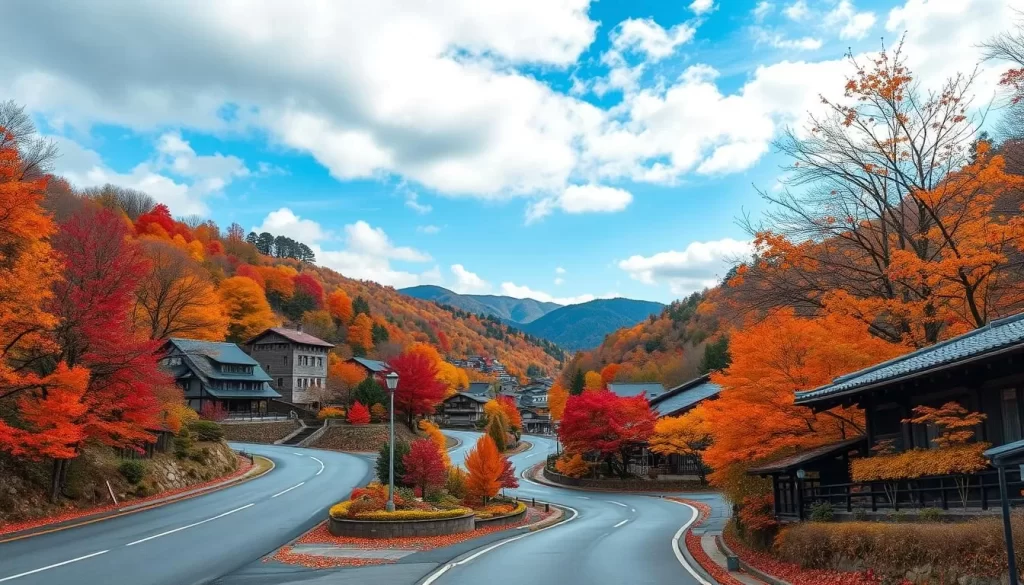
The Hakusan Shirakawa-go White Road offers a unique driving experience through Hakusan National Park’s stunning scenery. This road is a significant route that bisects the park, providing access to various attractions and breathtaking viewpoints.
The drive typically starts from Ichirino Onsen Ski Resort in the west, which is also the closest winter sports center. As you drive along this route, you’ll be treated to diverse landscapes that change with the seasons.
Key Stops and Viewpoints Along the Route
Several stops and viewpoints along the Hakusan Shirakawa-go White Road make the journey even more enjoyable. You can stop at designated viewpoints to take in the panoramic views of the surrounding mountains and valleys.
Some of the key attractions include scenic overlooks, hiking trailheads, and picturesque lakes. The road also passes through tunnels and narrow sections, adding to the excitement of the drive.
During peak travel times, such as summer weekends and autumn foliage season, the road can be busier. However, driving early in the morning or on weekdays can provide a more peaceful experience and better opportunities to witness the “sea of clouds” phenomenon.
Practical Information: Seasonal Closures and Driving Tips
The Hakusan Shirakawa-go White Road is typically open from late April through mid-November. The exact opening and closing dates are determined by snow conditions, which can vary significantly from year to year.
It’s essential to note that the road is completely closed during winter due to heavy snowfall. You’ll need to plan alternative routes between the eastern and western sides of the park during this time.
A toll fee of approximately 1,600 yen for standard vehicles applies to use the road. While there is a cost, the spectacular scenery and access to multiple attractions make it a worthwhile expense for a day trip.
When driving on the Hakusan Shirakawa-go White Road, be cautious, especially in narrow sections and tunnels. The scenic drive is a highlight of visiting Hakusan National Park, and with some planning, you can have a safe and enjoyable trip.
Conclusion: Embracing the Natural and Spiritual Beauty of Hakusan
With its breathtaking landscapes and profound cultural significance, Hakusan National Park is a destination that will leave you in awe. As you’ve discovered through this journey, the park is not just a natural wonder but a spiritual haven that has been revered for centuries. The history of mountain worship, dating back to the year 717 when Taicho Daishi first climbed the mountain, underscores the park’s importance as a sacred site.
Hakusan National Park offers a diverse range of experiences that cater to different interests. Whether you’re drawn to the hiking challenges of its iconic trails, the beauty of its alpine flora, or the tranquility of its hot springs, the park has something to offer. The park’s wildlife, including Japanese serows, golden eagles, and Asiatic black bears, adds another layer of fascination to your visit.
The park’s accessibility from major cities like Kanazawa makes it an ideal destination for those seeking to experience Japan’s natural beauty without the crowds often found at more famous destinations. As you plan your visit, consider the unique charm of each season – from the summer wildflower spectacles to the autumn foliage, and from the winter snow-covered landscapes to the spring renewal. This seasonal variety makes Hakusan a destination worth returning to time and again.
As you reflect on the experiences and landscapes that Hakusan National Park offers, it’s clear that this is a place where nature and spirituality converge. The park’s rich history, diverse wildlife, and breathtaking natural beauty make it a truly unique national park experience. Whether you’re a nature lover, a hiker, or someone seeking spiritual solace, Hakusan National Park is a place that will touch your heart and leave a lasting impression.
In embracing the natural and spiritual beauty of Hakusan, you’re not just visiting a national park; you’re experiencing a profound part of Japan’s cultural and natural heritage. As you leave this sacred mountain paradise, you’ll carry with you memories of its serene landscapes, its vibrant flora and fauna, and the spiritual energy that permeates this special place.
The journey to Hakusan National Park is a journey of discovery – of nature, of culture, and of oneself. It’s an invitation to explore the depths of Japan’s natural beauty and spiritual traditions, and to experience the world in a new and meaningful way.
The above is subject to change.
Check back often to TRAVEL.COM for the latest travel tips and deals.






